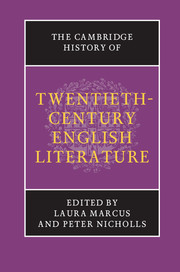Book contents
- Frontmatter
- Introduction
- PART ONE WRITING MODERNITY
- PART TWO THE EMERGING AVANT-GARDE
- PART THREE MODERNISM AND ITS AFTERMATH, 1918–1945
- 10 Trauma and war memory
- 11 The time–mind of the twenties
- 12 Modern life: fiction and satire
- 13 Modernist poetry and poetics
- 14 Modernity and myth
- 15 Psychoanalysis and literature
- 16 Biography and autobiography
- 17 ‘Speed, violence, women, America’: popular fictions
- 18 Theatre and drama between the wars
- 19 Literature and cinema
- 20 The thirties: politics, authority, perspective
- 21 Literary criticism and cultural politics
- 22 Surrealism in England
- 23 World War II: contested Europe
- 24 World War II: the city in ruins
- PART FOUR POST-WAR CULTURES, 1945–1970
- PART FIVE TOWARDS THE MILLENNIUM, 1970–2000
- Bibliography
- Index
- References
16 - Biography and autobiography
from PART THREE - MODERNISM AND ITS AFTERMATH, 1918–1945
Published online by Cambridge University Press: 28 March 2008
- Frontmatter
- Introduction
- PART ONE WRITING MODERNITY
- PART TWO THE EMERGING AVANT-GARDE
- PART THREE MODERNISM AND ITS AFTERMATH, 1918–1945
- 10 Trauma and war memory
- 11 The time–mind of the twenties
- 12 Modern life: fiction and satire
- 13 Modernist poetry and poetics
- 14 Modernity and myth
- 15 Psychoanalysis and literature
- 16 Biography and autobiography
- 17 ‘Speed, violence, women, America’: popular fictions
- 18 Theatre and drama between the wars
- 19 Literature and cinema
- 20 The thirties: politics, authority, perspective
- 21 Literary criticism and cultural politics
- 22 Surrealism in England
- 23 World War II: contested Europe
- 24 World War II: the city in ruins
- PART FOUR POST-WAR CULTURES, 1945–1970
- PART FIVE TOWARDS THE MILLENNIUM, 1970–2000
- Bibliography
- Index
- References
Summary
Life-writing in the twentieth century’s era of experiment and modernity has demonstrated that there is still life in its forms. The culture industries have found them persistently lucrative. Lives of royals, generals, politicians and other performers endure on the bestseller lists. Educationalists and clerics may have given way to sports and media ‘personalities’, but the investment in the biographic remains massive. The ‘biopic’ emerged as a staple of the film industry in this period. There is enough biographical documentary to programme a Biography Channel for television.
This continued proliferation of the producing and consuming of auto/biography isn’t reducible to a single grand narrative of shifts and developments. In part this is because the genres of life-writing are less well-researched than plays, poems or novels – though they have begun to attract more critical attention in the last two decades. But also because, just as realism has flourished in fiction and film alongside and despite other forms (Absurdist, Existentialist, magic realist, supernaturalist, metafictional, Postmodernist), so fundamentally realist biography and autobiography have flourished among more experimental forms of life-writing. This diversity of forms (what we might call ‘auto/biodiversity’) is arguably part of the condition of postmodernity. How we got there is perhaps best explained in terms of a sequence of challenges – from history, from criticism – to the received forms: challenges which have in turn produced new forms of life-writing and new modes of understanding the genres involved, and generated a new terminology.
- Type
- Chapter
- Information
- The Cambridge History of Twentieth-Century English Literature , pp. 286 - 303Publisher: Cambridge University PressPrint publication year: 2005
References
- 2
- Cited by

